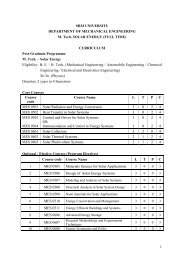âForensic Clinical Psychology as an Emerging ... - SRM University
âForensic Clinical Psychology as an Emerging ... - SRM University
âForensic Clinical Psychology as an Emerging ... - SRM University
Create successful ePaper yourself
Turn your PDF publications into a flip-book with our unique Google optimized e-Paper software.
FORENSIC ISSUE OF MENTAL RETARDATION<br />
DR.K. R<strong>an</strong>g<strong>as</strong>wami. M.A., DM & SP, Ph.D<br />
FORMER DEAN AND PROF OF CLINICAL PSYCHOLOGY<br />
S.R.I, SECUNDERABAD<br />
Mentally retarded present a complex problem for the courts <strong>an</strong>d correctional facilities. It is<br />
estimated that although the prevalence of mental retardation is less th<strong>an</strong> 1-2% of the population,<br />
mentally retarded individuals represent 4-10% of those in the criminal justice system (Petersilia,<br />
1997; Sundram, 1990). The deficits of mentally retarded individuals are not always readily apparent<br />
to the forensic clinici<strong>an</strong>. M<strong>an</strong>y intellectually impaired go through the criminal justice system<br />
without adequate attention to their unique needs. Mentally retarded individuals are at a distinct<br />
disadv<strong>an</strong>tage. Mentally retarded individuals are more likely to waive essential rights, to confess, to<br />
go to trial, to plead guilty, (Goldm<strong>an</strong>, 2001)<br />
The disabilities are of these people commonly missed by the police, lawyers, <strong>an</strong>d the correctional<br />
system. Questions regarding competence <strong>an</strong>d criminal responsibility are rarely raised, with those<br />
individuals with mild retardation.<br />
Definition of Mental Retardation: The Americ<strong>an</strong> Association of Mental Retardation (AAMR,<br />
2002) defines mental retardation <strong>as</strong> being characterized by sub average intellectual functioning<br />
<strong>as</strong> indicated by <strong>an</strong> IQ that is at le<strong>as</strong>t two st<strong>an</strong>dard deviations below the me<strong>an</strong> of a given me<strong>as</strong>ure<br />
of intelligence, which typically tr<strong>an</strong>slates into a cutoff IQ score of approximately 70 on most<br />
intellectual me<strong>as</strong>ures. Intellectual deficits alone are not sufficient for diagnosis but must also be<br />
accomp<strong>an</strong>ied by limitations in adaptive skills deficits in the are<strong>as</strong> of social functioning, conceptual<br />
skills, communication, <strong>an</strong>d practical daily living skills, <strong>as</strong> indicated by perform<strong>an</strong>ce on me<strong>as</strong>ures of<br />
adaptive functioning that are two st<strong>an</strong>dard deviations, below the me<strong>an</strong> (AMMR, 2002).<br />
The Americ<strong>an</strong> Psychiatric Association’s definition of mental retardation is similar, requiring a threepronged<br />
criterion of (1) <strong>an</strong> IQ less th<strong>an</strong> 70; (2) deficits in adaptive functioning, <strong>an</strong>d (3) onset before<br />
age 18 (Americ<strong>an</strong> Psychiatric Association [APA], 2000). However IQ scores c<strong>an</strong> vary over time <strong>an</strong>d<br />
across situations <strong>an</strong>d carry with them a degree of testing error (K<strong>an</strong>aya et al., 2003).<br />
The etiology of mental retardation is multifactorial <strong>an</strong>d involves numerous risk factors. The AMMR<br />
identifies four categories of risk for development of mental retardation (biomedical, social,<br />
behavioral, <strong>an</strong>d educational) that c<strong>an</strong> occur across three time dimensions (prenatal, perinatal <strong>an</strong>d<br />
postnatal) (AMMR, 2002). Most of the mentally retarded individuals are in the mild r<strong>an</strong>ge of mental<br />
retardation, corresponding to IQ between 55 <strong>an</strong>d 75. Individuals with mild mental retardation<br />
usually do not have <strong>an</strong> outward sign of disability <strong>an</strong>d appear to the general public <strong>as</strong> “normal”.<br />
Severe forms of mental retardation are screened out because their intellectual deficits are obvious.<br />
They have noticeable communication difficulties, <strong>an</strong>d <strong>as</strong>sociated physical problems that are apparel<br />
to the c<strong>as</strong>ual observer. In contr<strong>as</strong>t, individuals with mild mental retardation may not be recognized<br />
until the initiation of legal process.
















